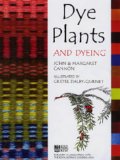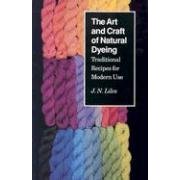Dyeing with Oregon Grapes (Mahonia Aquifolium)
Name: Joyce
—ADVERTISEMENTS—
Books About Natural Dyes
by John & Margaret Cannon
Dye Plants and Dyeing

The Art and Craft
of Natural Dyeing:
Traditional Recipes for Modern Use
by Jim Liles

The Dyer's Garden
by Rita Buchanan


The Complete Guide to Natural Dyeing
by Eva Lambert

Country or region: USA
Message: I'm a freelance writer working on an assignment on Oregon Grapes (Mahonia Aquifolium). Numerous sources say the inner bark and roots of this plant have been used for a yellow dye and the berries for a blue dye. I'm trying to find someone who has actually worked with Oregon Grape-derived dyes and can tell me his/her experiences. Thank you.
I don't know anyone who works with Oregon Grape, but I can give you more information on the chemistry of the dyestuffs contained in it, and a couple of recipes for dyeing with it.
Blue and purple berries generally make poor dyes. Their natural anthocyanin pigments, the source of the blue color, do not maintain their color at all well after laundering. For a natural purple dye, you can get far longer-lasting color by using logwood; for a natural blue, nothing else approaches indigo. In my opinion, berries and grapes of any sort are suitable as a blue or purple dye only for projects that will never have to be washed. (A relevant posting in my blog about an anthocyanin-based plant dye is "How can I dye with foods such as blueberries?".)
The yellow from the roots and inner bark is a better dye than the purple from the grapes, however, since it lasts longer. Yellow dyes are extremely common in nature. The majority of dyeplants produce yellow dyes, many of them unfortunately susceptible to light fading. One of the most light-resistant of natural yellow dyes is quercitron, which comes from the inner bark of black oak trees.
It's important to note that large quantities of any natural dyestuff must be used to obtain a good color. Non-dyers are often surprised to learn that, rather than a small handful, you must often use two to three times the weight of dye plant, as compared to the weight of the fiber to be dyed. Large quantities of the dye plant must be harvested to color even small quantities of fiber.
John & Margaret Cannon's book, Dye Plants and Dyeing , published by Timber Press in 1994 and 2002, contains a paragraph on Oregon Grape in their entry on mahonias, on page 78 in the 2002 edition:
, published by Timber Press in 1994 and 2002, contains a paragraph on Oregon Grape in their entry on mahonias, on page 78 in the 2002 edition:
"Mahonia aquifolium, the Oregon Grape, is a native of western North America. It is naturalized in some places in Europe and is widely cultivated in parks and gardens. These shrubs have leaves with 5 to 9 leaflets which resemble holly, small yellow flowers and blue-black berries. The bright orange roots and the stems produce fairly permanent golden-yellow and brownish-reds. The dyes present are the alkaloids berberine, beramine, and oxyacanthine. The berries are best in an acid solution, when they produce violet-blues. The pigments present are anthocyanins. The Navaho Indians of the southwest United States use Oregon grape for dyeing, but their use of vegetable dyes, with the possible exception of indigo and goldenrod, was introduced as late as the 1920s and is not of historical importance."
It's interesting to know that berberine is one of the dye chemicals in Oregon Grape. Berberine is found in a number of different plants, including goldenseal and barberry, and has been used for various medicinal purposes. There are many references to it in the medical literature: see PubMed. There also seems to be useful information in the Wikipedia entry on berberine.
There are two recipes available for dyeing with Oregon Grape in the 1935 booklet, "Home Dyeing with Natural Dyes", by Margaret S. Furry and Bess M. Viemont:
"The coloring matter contained in Hollygrape root is berberine, the
same as that present in the bark and root of barberry. It is one of
the few natural basic dyestuffs. Hollygrape, or Oregon grape as it
is sometimes called, grows in the Northwestern States. On wool,
hollygrape root gives a buff and a light tan which have fair color
fastness. On cotton its colors are not fast.
Buff.—For each pound of wool mordanted with alum, allow:
1 peck chopped hollygrape root. [one peck equals two gallons]
Mordant the wool with alum (p. 6). Soak the chopped root over- night in water to cover. In the morning boil for 2 hours, strain, and add enough water to make 4 to 4% gallons for the dye bath. Immerse the yarn or cloth thoroughly rinsed and squeezed out of water and boil for 30 minutes. Rinse and dry. Tan.—For each pound of wool mordanted with alum, allow:
1 peck chopped hollygrape root.
1/6 ounce potassium dichromate.
1/6 ounce acetic acid, or 6 to 7 tablespoons vinegar.
Mordant the wool with alum (p. 6) and dye as directed above. Without rinsing put into a boiling bath of the potassium dichromate and acetic acid, stir carefully, and boil 10 minutes longer. Rinse and dry."
I strongly recommend against following any recipe, such as the above recipe for tan, that calls for potassium dichromate. Potassium dichromate is based on the known human carcinogen trivalent chromium. Trivalent chromium does not belong in the home or art studio. There have been many deaths and serious illnesses caused by careless use of potassium dichromate, and there are plenty of natural dyes which can be used much more safely, if due care is taken, that do not call for the use of this dangerous substance.1 peck chopped hollygrape root. [one peck equals two gallons]
Mordant the wool with alum (p. 6). Soak the chopped root over- night in water to cover. In the morning boil for 2 hours, strain, and add enough water to make 4 to 4% gallons for the dye bath. Immerse the yarn or cloth thoroughly rinsed and squeezed out of water and boil for 30 minutes. Rinse and dry. Tan.—For each pound of wool mordanted with alum, allow:
1 peck chopped hollygrape root.
1/6 ounce potassium dichromate.
1/6 ounce acetic acid, or 6 to 7 tablespoons vinegar.
Mordant the wool with alum (p. 6) and dye as directed above. Without rinsing put into a boiling bath of the potassium dichromate and acetic acid, stir carefully, and boil 10 minutes longer. Rinse and dry."
Buff is such an easily obtained color, using other dyestuffs, that I see little reason to bother with using Oregon grape as a dye. Its historical use would be more interesting, except that it appears that the plant was not used historically as a dye by the Navaho Indians; only if it were to turn out that another group of people did use the dye historically would that issue become interesting.
(Please help support this web site. Thank you.)
(Please help support this web site. Thank you.)
Posted: Tuesday - March 20, 2012 at 10:17 AM
Follow this blog on twitter here.
Quick Links
- All About Dyes & Dyeing Top -
- Top of this blog -
- FAQ -
- The Dye Forum -
- How to Tie Dye - How to Batik -
- Books - Toys - Plants -
- Top of this blog -
- FAQ -
- The Dye Forum -
- How to Tie Dye - How to Batik -
- Books - Toys - Plants -
More in this category:
- -
Statistics
Total entries in this blog:
Total entries in this category:
Published On: Aug 29, 2012 02:49 PM
Total entries in this category:
Published On: Aug 29, 2012 02:49 PM
